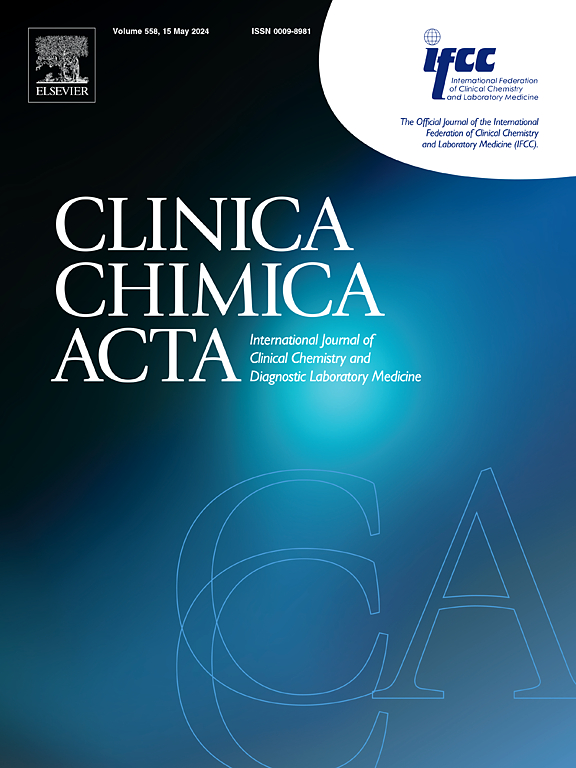Sclerostin in ankylosing spondylitis: A meta-analysis
IF 3.2
3区 医学
Q2 MEDICAL LABORATORY TECHNOLOGY
引用次数: 0
Abstract
Objective
This study aims to assess circulating sclerostin levels in patients with ankylosing spondylitis (AS).
Methods
The databases of PubMed, Embase, Medline, Web of Science, The Cochrane Library, China National Knowledge Infrastructure Database (CNKI), China Biomedical Literature Database (CBM), Wanfang Med Online Database (Wanfang), China Science and Technology Journal Database (VIP) were used to collect all relevant published articles (up to 26 August 2024). The pooled standardized mean difference (SMD) with 95% confidence interval (CI) was calculated by the random-effect model.
Results
A total of 22 studies were included, including 1354 AS patients and 871 normal controls. There was no significant difference in the circulating sclerostin levels between AS patients and normal controls (SMD = −0.03, 95%CI = −0.51 to 0.46, P = 0.92). Subgroup analysis showed that the South America group, the Africa group, cohort study group, bath ankylosing spondylitis disease activity index (BASDAI) score < 4 group, bath ankylosing spondylitis functional index (BASFI) score < 4 group, C-reactive protein (CRP) ≤ 10 mg/L group, modified stoke ankylosing spondylitis spinal score (mSASSS) ≥ 30 group, TECO medical group and other enzyme-linked immunosorbent assay (ELISA) kits group had lower levels of the circulating sclerostin. Egger’s linear regression test indicated that there was no significant publication bias. Sensitivity analysis showed that the results were stable.
Conclusion
There was no significant difference in circulating sclerostin levels between AS patients and normal controls. However, the circulating sclerostin levels in AS patients were influenced by region, type of study, BASDAI score, BASFI score, CRP, mSASSS, and ELISA kits. Therefore, it may serve as an indicator to evaluate disease activity, functional status, inflammation and imaging progression in AS patients.
硬化剂治疗强直性脊柱炎:荟萃分析。
目的:本研究旨在评估强直性脊柱炎(AS)患者的循环硬化蛋白水平。方法:使用PubMed、Embase、Medline、Web of Science、Cochrane Library、中国国家知识基础数据库(CNKI)、中国生物医学文献数据库(CBM)、万方医学在线数据库(Wanfang)、中国科技期刊数据库(VIP)等数据库收集截至2024年8月26日的所有相关已发表文章。采用随机效应模型计算95%置信区间(CI)的合并标准化平均差(SMD)。结果:共纳入22项研究,其中AS患者1354例,正常对照871例。AS患者与正常对照组的循环硬化蛋白水平无显著差异(SMD = -0.03,95% %CI = -0.51 ~ 0.46,P = 0.92)。亚组分析显示,南美洲组、非洲组、队列研究组浴强直性脊柱炎疾病活动指数(BASDAI)评分 结论:AS患者与正常对照组循环硬化蛋白水平无显著差异。然而,AS患者的循环硬化蛋白水平受地区、研究类型、BASDAI评分、BASFI评分、CRP、mSASSS和ELISA试剂盒的影响。因此,它可以作为评价as患者疾病活动性、功能状态、炎症和影像学进展的指标。
本文章由计算机程序翻译,如有差异,请以英文原文为准。
求助全文
约1分钟内获得全文
求助全文
来源期刊

Clinica Chimica Acta
医学-医学实验技术
CiteScore
10.10
自引率
2.00%
发文量
1268
审稿时长
23 days
期刊介绍:
The Official Journal of the International Federation of Clinical Chemistry and Laboratory Medicine (IFCC)
Clinica Chimica Acta is a high-quality journal which publishes original Research Communications in the field of clinical chemistry and laboratory medicine, defined as the diagnostic application of chemistry, biochemistry, immunochemistry, biochemical aspects of hematology, toxicology, and molecular biology to the study of human disease in body fluids and cells.
The objective of the journal is to publish novel information leading to a better understanding of biological mechanisms of human diseases, their prevention, diagnosis, and patient management. Reports of an applied clinical character are also welcome. Papers concerned with normal metabolic processes or with constituents of normal cells or body fluids, such as reports of experimental or clinical studies in animals, are only considered when they are clearly and directly relevant to human disease. Evaluation of commercial products have a low priority for publication, unless they are novel or represent a technological breakthrough. Studies dealing with effects of drugs and natural products and studies dealing with the redox status in various diseases are not within the journal''s scope. Development and evaluation of novel analytical methodologies where applicable to diagnostic clinical chemistry and laboratory medicine, including point-of-care testing, and topics on laboratory management and informatics will also be considered. Studies focused on emerging diagnostic technologies and (big) data analysis procedures including digitalization, mobile Health, and artificial Intelligence applied to Laboratory Medicine are also of interest.
 求助内容:
求助内容: 应助结果提醒方式:
应助结果提醒方式:


